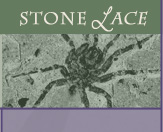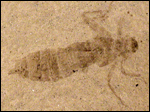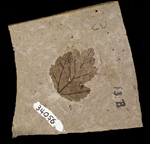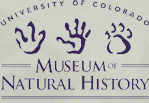 |
 |
||
Page 7 To view larger versions of the images below, click on a thumbnail image or the specimen name. The larger version will display in a new browser window. Use the page number links below the images to return to a previous page.   Lithocicada perita wing, Platypedia primigenia complete), Common Name: Cicada (UCM #4554 wing, UCM #29658 complete). Cicadas are probably best known for the loud distinctive sound that they make. This sound is made only by the males and each species has its own distinct song. Many have a lifecycle that runs from 4-17 years. Usually, many species overlap in a single year - adding their unique sounds to the Cicada chorus. Lithocicada perita wing, Platypedia primigenia complete), Common Name: Cicada (UCM #4554 wing, UCM #29658 complete). Cicadas are probably best known for the loud distinctive sound that they make. This sound is made only by the males and each species has its own distinct song. Many have a lifecycle that runs from 4-17 years. Usually, many species overlap in a single year - adding their unique sounds to the Cicada chorus. Aeschna larvata, Common Name: Dragonfly nymph (UCM #31090). Dragonflies start out as aquatic nymphs. They are voracious aquatic predators and will chase down prey. They have strong and extendable mouthparts that shoot out from the head and grab prey (think of the movie Aliens). The Aeschna includes some of the largest living dragonflies and they are often brightly colored. Aeschna larvata, Common Name: Dragonfly nymph (UCM #31090). Dragonflies start out as aquatic nymphs. They are voracious aquatic predators and will chase down prey. They have strong and extendable mouthparts that shoot out from the head and grab prey (think of the movie Aliens). The Aeschna includes some of the largest living dragonflies and they are often brightly colored. Acer florissantii, Common Name: Maple (UCM #34056). Acer florissantii is an extinct species of maple. Maple trees have a distribution in tropical to temperate climates. Today, maple trees are used commercially for lumber, as ornamentals in landscapes, and the sap of some species can be used to produce edible syrup. Acer florissantii, Common Name: Maple (UCM #34056). Acer florissantii is an extinct species of maple. Maple trees have a distribution in tropical to temperate climates. Today, maple trees are used commercially for lumber, as ornamentals in landscapes, and the sap of some species can be used to produce edible syrup. Amyzon commune, Common Name: Sucker (UCM #15377). This fossil fish has been preserved in exquisite detail. Each bone of the spine, fins, and skull has been preserved in three dimensions and the outline of the body can still be seen in contrast against the light colored background of the shale. This fish was a sucker, most likely feeding on small particles on the bottom of the lake, or perhaps in one of the rivers that fed into lake Florissant. Amyzon commune, Common Name: Sucker (UCM #15377). This fossil fish has been preserved in exquisite detail. Each bone of the spine, fins, and skull has been preserved in three dimensions and the outline of the body can still be seen in contrast against the light colored background of the shale. This fish was a sucker, most likely feeding on small particles on the bottom of the lake, or perhaps in one of the rivers that fed into lake Florissant. |

|
||
|
|
|||
|
|||
